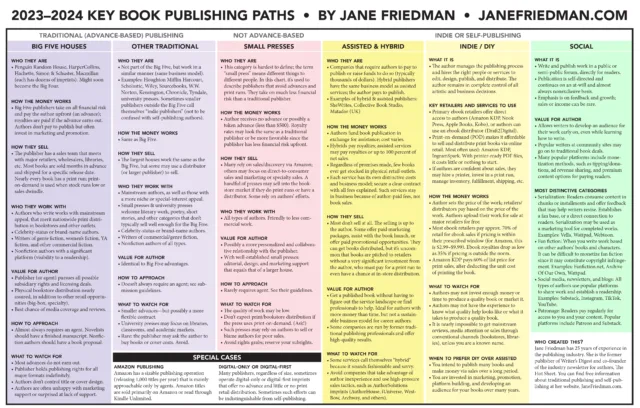From Elysian:
In 2022, Penguin Random House wanted to buy Simon & Schuster. The two publishing houses made up 37 percent and 11 percent of the market share, according to the filing, and combined they would have condensed the Big Five publishing houses into the Big Four. But the government intervened and brought an antitrust case against Penguin to determine whether that would create a monopoly.
The judge ultimately ruled that the merger would create a monopoly and blocked the $2.2 billion purchase. But during the trial, the head of every major publishing house and literary agency got up on the stand to speak about the publishing industry and give numbers, giving us an eye-opening account of the industry from the inside. All of the transcripts from the trial were compiled into a book called The Trial. It took me a year to read, but I’ve finally summarized my findings and pulled out all the compelling highlights.
I think I can sum up what I’ve learned like this: The Big Five publishing houses spend most of their money on book advances for big celebrities like Brittany Spears and franchise authors like James Patterson and this is the bulk of their business. They also sell a lot of Bibles, repeat best sellers like Lord of the Rings, and children’s books like The Very Hungry Caterpillar. These two market categories (celebrity books and repeat bestsellers from the backlist) make up the entirety of the publishing industry and even fund their vanity project: publishing all the rest of the books we think about when we think about book publishing (which make no money at all and typically sell less than 1,000 copies).
But let’s dig into everything they said in detail.
In my essay “Writing books isn’t a good idea” I wrote that, in 2020, only 268 titles sold more than 100,000 copies, and 96 percent of books sold less than 1,000 copies. That’s still the vibe.
Q. Do you know approximately how many authors there are across the industry with 500,000 units or more during this four-year period?
A. My understanding is that it was about 50.
Q. 50 authors across the publishing industry who during this four-year period sold more than 500,000 units in a single year?
A. Yes.
Madeline Mcintosh , CEO, Penguin Random House US
The DOJ’s lawyer collected data on 58,000 titles published in a year and discovered that 90 percent of them sold fewer than 2,000 copies and 50 percent sold less than a dozen copies.
In my essay “No one will read your book,” I said that publishing houses work more like venture capitalists. They invest small sums in lots of books in hopes that one of them breaks out and becomes a unicorn, making enough money to fund all the rest.
Turns out, they agree!
Every year, in thousands of ideas and dreams, only a few make it to the top. So I call it the Silicon Valley of media. We are angel investors of our authors and their dreams, their stories. That’s how I call my editors and publishers: angels… It’s rather this idea of Silicon Valley, you see 35 percent are profitable; 50 on a contribution basis. So every book has that same likelihood of succeeding.
— Markus Dohle, CEO, Penguin Random House
Those unicorns happen every five to 10 years or so.
We’re very hit driven. When a book is successful, it can be wildly successful. There are books that sell millions and millions of copies, and those are financial gushes for the publishers of that book, sometimes for years to come… A gusher is once in a decade or something. For instance, I don’t know if you know the Twilight series of books? Hachette published the Twilight series of books, and those made hundreds of millions of dollars over the course of time.
Right now the novels of Colleen Hoover are topping the bestseller lists in really, really huge numbers and the publishers of those books are making a lot of money. You probably remember The Girl With the Dragon Tattoo… Or the Fifty Shades of Grey series. So once every five years, ten years, those come along for the whole industry and become the industry driver that’s drawing people into bookstores because there is such a commotion about them.
— Michael Pietsch, CEO, Hachette
Big advances go to celebrities
They spent a lot of the trial talking about books that made an advance of more than $250,000—they called these “anticipated top-sellers.” According to Nicholas Hill, a partner at Bates White Economic Consulting, 2 percent of all titles earn an advance over $250,000.
Publisher’s Marketplace says it’s even lower.
Top-selling authors were defined as those receiving advances (i.e., guaranteed money) in excess of $250,000. Far fewer than 1 percent of authors receive advances over that mark; Publishers Marketplace, which tracks these things, recorded 233 such deals in all of 2022.
Ken Whyte, Publisher at Sutherland House
Hill says titles that earn advances over $250,000 account for 70 percent of advance spending by publishing houses. At Penguin Random House, it’s even more. The bulk of their advance spending goes to deals worth $1 million or more, and there are about 200 of those deals a year. Of the roughly $370 million they say PRH accounts for, $200 million of that goes to advance deals worth $1 million or more.
. . . .
Books by the Obamas sold so many copies they had to be removed from the charts as statistical anomalies.
There are giant celebrities Michelle Obama where you know it’s going to be a top seller.
— Jennifer Rudolph Walsch, Literary Agent
Because they are so lucrative, Gallery Books Group focuses its efforts on trying to get celebrities to write books.
75 percent [of our] acquisitions come from approaching celebrities, politicians, athletes, the “celebrity adjacent,” etc. That way, we can control the content…. We are approaching authors and celebrities and politicians and athletes for ideas. So it’s really we are on the look out. We are scouts in a lot of ways…
— Jennifer Bergstrom, SVP, Gallery Books Group
Bergstrom said her biggest celebrity sale was Amy Schumer who received millions of dollars for her advance.
We’ve had a lot of success publishing musicians, I mentioned Bruce Springsteen. We’ve also published Bob Dylan and Linda Ronstadt, a lot of entertainers through the years… There was a political writer, Ben Shapiro, who has a very popular podcast and a large following. We also competed with HarperCollins for that.
— Jonathan Karp, CEO, Simon & Schuster
Penguin Random House US has guidelines for who gets what advance:
- Category 1: Lead titles with a sales goal of 75,000 units and up
- Advance: $500,000 and up
- Category 2: Titles with a sales goal of 25,000-75,000 units
- Advance: $150,000-$500,000
- Category 3: Titles with a sales goal of 10,000-25,000 units
- Advance: $50,000- $150,000
- Category 4: Titles with a sales goal of 5,000 to 10,000 units
- Advance: $50,000 or less
Is anyone else alarmed that the top tier is book sales of 75,000 units and up?
. . . .
Publishing houses want a built-in audience
The advantage of publishing celebrity books is that they have a built-in audience.
In some of the cases, the reason they are paying big money is because the person has a big platform. And if that platform is there for the advertising, then the spend might be lower.
Jennifer Rudolph Walsh, former Agent
Macmillan agrees.
Q. Would you agree that those type of authors, meaning the ones with the built-in audience, are also authors who would command a high advance if they went to a traditional publisher like Macmillan or PRH?
A. That’s a broad brush. But, yes…
Q. And you’re willing to pay more if they have a significant following?
Donald Weisberg, CEO, Macmillan Publishers
Link to the rest at Elysian and thanks to P. for the tip.
PG notes the OP is much longer than his excerpt and appears to be well-researched. He’s signed up for a free email newsletter from the site.

